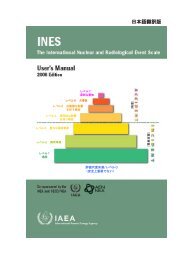Guidelines for Iodine Prophylaxis following Nuclear Accidents
Iodine_Prophylaxis_guide
Iodine_Prophylaxis_guide
You also want an ePaper? Increase the reach of your titles
YUMPU automatically turns print PDFs into web optimized ePapers that Google loves.
<strong>Guidelines</strong> <strong>for</strong> iodine prophylaxis <strong>following</strong> nuclear accidents1999 updateFig. 1. Averted dose as a function of time stable iodine is administeredrelative to a 4-h intake of 131 I <strong>for</strong> different dietary iodine intakes1,21Averted dose (arbitrary units)0,80,60,40,20-12 -9 -6 -3 0 3 6 9 12 15 18 21 24Time (h) stable iodine administered be<strong>for</strong>e or after start of 4h intake of 131 IIn some circumstances stable iodine administration may also bepractical in limiting the dose to the thyroid from ingested radioactiveiodine, especially to children via the milk pathway where alternativesources cannot be found. In that case, a daily dose of stable iodinemay be given <strong>for</strong> the time period needed to those children who showno adverse reaction. Repeated administrations should not be given toneonates, or to pregnant or lactating women (see section 3.2).Due consideration should be given, in preparing emergency plans, tomitigating any adverse psychosocial reactions to the implementationof iodine prophylaxis. To avoid public concern, distribution andinstructions to different age groups must be orderly and consistent.There are advantages in consulting with neighbouring countries withregard to their national policy in order to avoid discrepancies ofapproach, especially where reactors are close to national borders.References1. KAZAKOV, V.S. ET AL. Thyroid cancer after Chernobyl. Nature, 359:21–22 (1992).20






